Mothers, Heroes and First Ladies
by Sandra Martin
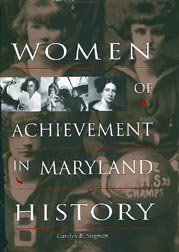 On Mother’s Day — and the other 364 days of the year — meet Women of Achievement in Maryland History, brought to you by former First Lady Frances Hughes Glendening.
On Mother’s Day — and the other 364 days of the year — meet Women of Achievement in Maryland History, brought to you by former First Lady Frances Hughes Glendening.
That TV sitcom mom is a fairy tale. In thrall to her husband, enraptured by technology, wrapped up in her children, she was imagined by advertising men selling security, Pillsbury flour and Hoovers to GIs traumatized by World War II. Mom tried out the role for the short generation between that war and Vietnam. She got so bored that she burned her bra and became a feminist.
Motherhood far outstrips any stereotype. From the beginning, mothers have labored to feed, clothe and shelter their children — all the while radiating nurture as the sun casts light.
Or, as Mary Ann Lundgren, director of the Women of Achievement in Maryland History project, writes: “Ever Since Eve, women have generated their vital force on the course of human progress.”
In the midst of her long day’s work, Mother has her own life to live — time or not — and men to relate to — for better or worse. Without paying much mind to it, she’s had history to make. It doesn’t matter if it ever got written; every mother makes the history that will be lived out by her children and grandchildren.
Maryland archivist Phebe Jacobsen understood that. “We are all part of history — the history of the human race,” she said.
It’s said that Ginger Rogers had to dance backwards and in high heels every step Fred Astair made. It’s true that Mom had to do it all as a second-class citizen, with kids balanced on her hips.
Even so, there have always been women who found the energy and the resolve to do even more.
One in 365 Maryland Heroes
Take Mary Shaw Shorb.
Shorb is one of 365 women — one for every day of the year and including Jacobsen though not Rogers — in the new book that emerged from the Women of Achievement in Maryland History project and that shares its title.
Shorb discovered Vitamin B12, which stops the deadly ravages of pernicious anemia.
For sure Shorb was dancing backwards. She started her research when men were going away to war.
Telling her story is Frances Hughes Glendening, first lady of Maryland from 1995 through 2001.
“Dr. Shorb was a wife and mother of three children. She pursued her doctoral degree at Johns Hopkins University and advanced her career at Beltsville Agricultural Research Center. When the men came back home, they displaced her. She was on the brink of discovery when she relinquished her job to a returning seviceman,” Glendening told Bay Weekly.
“But Dr. Shorb was relentless. She went to the poultry science department of the University of Maryland and begged to be allowed to continue her work. They took her as a volunteer, an unpaid research assistant. When she made her discovery in 1947, it was announced in Science magazine. Now the money came pouring in to her research.”
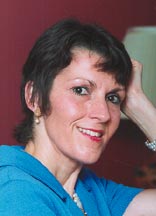 Hunting for Heroes
Hunting for Heroes
Glendening is rapt as she recounts Shorb’s endurance and triumph. Maryland’s seven-year first lady has always loved such stories.
“From a very young age,” continues Glendening, “I knew women were working in the community, but I didn’t see them. Very few held elected offices. I used to get very depressed, but my father said I needed to dig deeper.”
Glendening’s father, George R. Hughes Jr., served Allegany County as delegate, senator and judge. Public service was as much a part of her growing up as family dinner.
“Public service is the highest calling. I always wanted to have a role in public policy, and I wanted to be involved in both selection and election,” said Glendening. A lawyer, Glendening is widely credited as partner and strategist in her ex-husband Parris Glendening’s election and policies, first as Prince George’s County executive, then as governor.
As first lady, Glendening made discovering such stories official business. With private funding, she created the project that became Women of Achievement in Maryland History.
From Harriet Tubman (1820-1913, Dorchester County) to Shorb (1907-1990, Baltimore) to Romper Room’s Miss Nancy Goldman Claster (1915-1977, Baltimore County) to Olympic gymnast Dominique Dawes (1976, Montgomery County) Women of Achievement in Maryland History spans four centuries of Maryland women, pioneers who marked paths that many women now follow.
“Many struggled to overcome cruel inequities in their lives as they realized their dreams,” said Glendening, in her introduction to the book that crowns her work as Maryland’s first lady. “In numerous cases, their personal struggles became political, as they crusaded to improve the health education and welfare of citizens.”
The search for these women, followed by organization and writing, took six years. Assembling the book was the work of at least a couple hundred people: advisory and directing boards, author and a couple of editors, printer, a selection committee, six dozen volunteer researchers and donors, whose gifts ranged from $50,000 to $75.
The result is a hefty, 464-page reference book handsome enough to keep on your coffee-table and interesting enough that you’ll wish it wasn’t too big (eight and a half by 11 inches and an inch-and-a half thick) to read in bed.
It’s designed to draw you in and keep you a while. Biographies are brief — about a page each — and written as stories. Author Carolyn Stegman says she wanted to introduce each woman for herself, not just what she did: She usually succeeds. Some of the text hits its nail on the head with a heavy hammer. About Shorb, for example, you read “Doing so at a time when most other women accepted the status quo and stayed home to care for their families underscores Shorb’s determination to make a difference. She made her mark on medicine, Maryland and the world.” Sermon-like or no, the book tells the truth. These women made a better world, and the stories that push the conclusions are as good as popcorn: salty, savory delights that keep you reaching for more.
Illustrations also hold you to the pages. Almost every woman has a photo (for a few, no images could be found), and photo researcher Desdra Horwitz spent long hours in the National Archives digging up images to show readers the big picture of times and customs. You’ll see storytelling paintings of slaves, marching photos of suffragettes and smiling photos of school children, glamour photos of singers and heart-rending photos of sweat shop seamstresses.
But to see and read it, you can’t just call up Amazon.com. Women of Achievement was intended for distribution to all Maryland school and library systems, which just about used up the first printing; reprinting will take a whole new fund-raising campaign. Meanwhile, Glendening is hopeful that a backer will be found to bring the stories to public television.
Last month, libraries throughout the state got copies — every branch in Anne Arundel County has at least one — but only a few are available to check out, most being shelved in the reference section for library reading only.
Over 650 nominations were considered in choosing the 365 women, who are presented in seven categories of achievement: civil rights, education, community service, health and science, arts and culture, business and sports, law and public service.
They are slaves, suffragettes, singers, sisters and surgeons. They are judges, preachers, jockeys, authors, dancers, golfers, quilters and bank presidents. Among them are a Pulitzer Prize winner, a griot, nine senators and lots of teachers.
Some you’ll recognize, for their achievements have made them household names as well as patron saints of many an aspiring woman. Among the famous –
- Civil War nurse Clara Barton (1821-1912, Montgomery County);
- Art patrons Claribel and Etta Cone (1864-1929; 1870-1949, Baltimore);
- Arbiter of manners Emily Post (1872-1960, Baltimore County);
- Environmentalist Rachel Carson, author of the clarion-call best-seller Silent Spring (1907-1964 Montgomery County);
- Jazz singer Ethel Ennis (1932, Baltimore);
- National Public Radio talk show host Diane Rehm (1936, Montgomery County);
- Sen. Barbara Mikulski (1936, Baltimore County), the first woman independently elected to the U.S. Senate;
- Poet Lucille Clifton (1936, Baltimore);
- Victims rights advocate Roberta Roper (1937, Prince George’s County);
- Novelist Anne Tyler (1941, Baltimore County);
- Television celebrity Kathie Lee Gifford (1953, Prince George’s County).
Famous and unsung, the women span four centuries with Olympic gymnast Dominique Dawes (1976, Montgomery County) the youngest. They are Indians, Hispanics, African Americans, Irish and Italian Americans, Jewish Americans, Korean Americans, Pakistani Americans and one Chinese American.
Discovering Mary Lee Au (1931, Montgomery County) who champions the “place and significance of the Asian Pacific Americans in American history,” was a big deal for Jenny Sun, an immigrant Chinese American who works as a manicurist in Annapolis.
“I was happy to find her,” said Sun, who said the book introduced her to many ideas — and women — she had not imagined.
All are heroes, and in one sense all are also mothers and first ladies. Whether they bore children or not, these women are mothers of opportunity for women who followed. Many, as well, deserve the title because they dedicated themselves to the care of weaker souls. They are first ladies in the truest sense, because each boldly traveled where no woman had gone before.
Mother, First Lady and Hero
Mother, hero and first lady: Frances Hughes Glendening (1951, Prince George’s County) is all of those in every sense of the words.
She puts mother first, and she likes to say that her greatest achievement is her son, Raymond.
Home for a long weekend, Raymond, 25, woke late and tried to slip out for a game of golf. But he couldn’t escape before his mother urged him to “eat something healthy, dear.” He didn’t wince, and his response revealed the nature of their mother-son bond.
“I love you,” he said, even with a reporter in the room.
As Prince George’s County’s first lady for four years and Maryland’s for seven, Glendening gave the unpaid job shape, substance and seemingly full-time attention — all while working full time in Washington, D.C., in her paid job for years as legal counsel to a commissioner of the Federal Election Commission.
She first set about chronicling women of achievement when she was first lady of Prince George’s County. That project and book became the model for Women of Achievement in Maryland History, which Glendening began in 1996. Even earlier, she’d moved a smaller cadre of women of achievement into the limelight.
“When I came to Government House, I learned that many of Maryland’s first ladies had portraits, but they were stored away in the state archives,” Glendening said.
Another Maryland first lady, Helen Tawes, saw to it that first ladies and official hostesses, like Hilda Mae Snoops, got the recognition due them.
“In the 1960s, Helen Tawes decided that first ladies had jobs to do just like governors, and, like them, should have their portraits, too,” said Emily Oland Squires, director of biographic research at the Maryland State Archives. “So she petitioned the legislature for funding. All she could get was money for was hers and four previous first ladies. That’s how portraits of first ladies became official, though now the funding is private.”
Glendening brought the 10 official portraits of first ladies and official hostesses to Government House, displaying them on the home’s central staircase. Historic portraits of earlier first ladies hang in rooms decorated in their period. The portraits were the subject of two of the many art shows Glendening sponsored in her campaign to increase awareness of and support for the arts in Maryland. Her patronage also gave Maryland poet laureates during the Glendening administration.
As well as projects and patronage, Glendening made Government House a home that could be enjoyed by anyone who made the trip to State Circle in Annapolis. Over the holidays, she filled Government House with trees decorated with thousands of ornaments made by Maryland school children. For many a struggling arts organization, she sponsored receptions and dinners. Several days a week, Government House was open to all for tours.
Before she was done, Glendening put it all on the historic record. Twenty volumes of archival scrapbooks of each of her official projects as first lady, again privately paid for, have been compiled. Glendening has one copy; the state archives the other.
“She was an extremely active first lady and extremely concerned about what sort of legacy she could leave for others,” said Squires.
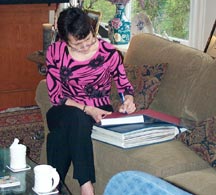 How does Frances Hughes Glendening sum up that legacy? I asked her on a rare holiday at home in the family’s brick colonial down the street from the University of Maryland in leafy University Park.
How does Frances Hughes Glendening sum up that legacy? I asked her on a rare holiday at home in the family’s brick colonial down the street from the University of Maryland in leafy University Park.
“It’s tough to get your arms around it,” she said, directing her high-energy rev into thought. “Making as many Marylanders as I can, of all areas of the state and walks of life, think they’re part of history while letting them see the great diverse community that is our state. I celebrate that diversity.”
If you were to name Frances Hughes Glendening’s space in the big territory of women of achievement in Maryland, you could do worse than to call it inclusion.
By the time you read this story, Glendening will have been inducted into another exclusive Circle of Excellence, reserved for women who have been thrice named to Maryland’s list of Top 100 Women complied by the Daily Record, a Maryland business and legal publication. Asked in the application to name a hero of her own, she chose two other mothers, first ladies and, to many, heroes: Jacqueline Bouvier Kennedy Onassis and Hillary Clinton.
By now, if you’re like this writer, nothing will do but to meet some of these women who rate such superlatives.
Everybody who worked on this project complains that skimming the cream of Maryland women of achievement is too hard. As Glendening said, “Each story is as compelling as the next. If she got there from that faraway place, I think as I read each story, I can get where I want.”
In choosing a few to introduce to you, I’ve followed my heart, selecting, as I browsed, stories that called to me. Your choices will certainly be different. Who they are, you’ll have to find out yourself.
to the top
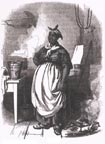 Ann Joice (1660-1735, Prince George’s County)
Ann Joice (1660-1735, Prince George’s County)
Ann Joice, the third woman in this big book, is the patron saint of righteous indignation. We can’t see what she looked like, but we can hear her voice whenever we raise our own against all the wrong that’s been done to us.
A West Indian by birth who’d lived in England, Joice came to Maryland with the Calverts and was taken on by an equally powerful family, the Darnells, who treated her as a slave. She, however, insisted she had been an indentured servant and was due her freedom. Ann Joice never gained her freedom or stopped complaining of the injustice she suffered. Her claim of freedom still echoed half a century after her death, when her grandson used her arguments in court to gain — apparently only temporarily — his own freedom.
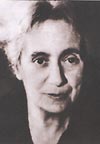 Henrietta Szold (1860-1945, Baltimore)
Henrietta Szold (1860-1945, Baltimore)
Henrietta Szold was a Jewish mother to thousands of children — and to their parents. The displaced people of a race in diaspora were all her children, and the last two centuries gave her a huge family. At home in Baltimore, the 22-year-old Szold began a thriving English school for refugees from anti-Semitic Russia. Fifty years later, she was welcoming the refugee children fleeing from Hitler to Palestine. “Because of her extraordinary efforts,” writes Women of Achievement author Carolyn Stegman, “some 13,000 children survived the Holocaust.” Szold was able to spread her arms so wide through the relief organization Hadassa, which she founded.
 Sarah Kneller Miller (1867-1920, Carroll County)
Sarah Kneller Miller (1867-1920, Carroll County)
The camera was new in Sarah Kneller Miller’s lifetime, and she made it her window on the world. From Pike’s Peak to the Panama Canal, from the St. Louis World’s Fair to presidential conventions, she saw and shot the exotic places and top events of her age. Beginning her career as a reporter, she may have been the first woman sports writer, for she covered the 19th century Orioles, disguising her gender in a byline of initials.
“No magazine could order me to make such perilous trips,” Sarah Kneller Miller wrote. “It was adventure and the spice of the thing that attracted me to do it and made its risk worth taking.”
After her death, her work was forgotten until Western Maryland College professor Keith Richwine rediscovered it. She is now recognized as the earliest of female photojournalist adventurers.
 Ola Elizabeth Winslow (1885-1977 Baltimore)
Ola Elizabeth Winslow (1885-1977 Baltimore)
In 1941, Goucher College American studies prof Ola Elizabeth Winslow thrilled herself, the thousands of students to whom she was mother of the mind and her colleagues by winning the Pulitzer Prize for biography. Her achievement wasn’t a first; Winslow was the second woman biographer to win the literary world’s most prestigious prize. She wrote on Jonathan Edwards, the brimstone-preaching 18th-century descendent of Puritans who engendered an awakening of faith in the colony’s second century. Winslow continued writing into her 80s, publishing in 1974 a book with a message for our times: A Destroying Angel: The Conquest of Smallpox in Colonial Boston.

Claire McCardell (1905-1958, Frederick County)
Fashion designer Claire McCardell gave American women the gift of clothing that let them use their bodies. “Clothing ought to be useful and comfortable,” McCardell said, defying the centuries-old fashion traditions that imprisoned women as effectively as suits of armor. Her signature garment was the monastic dress, a flowing, bias-cut dress with useful large pockets and liberating loose sleeves, sashed or belted at the waist. We can thank her, too, for zippers (incredibly, she was the first designer to use them) leotards, all our hooded shirts and sweatshirts, the pedal pushers now back in style, backless sundresses, strapless swimsuits and fashion denim.
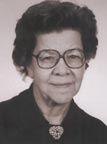 Phebe Jacobsen (1922-2000, Anne Arundel County)
Phebe Jacobsen (1922-2000, Anne Arundel County)
Phebe Jacobsen wanted to know the stories nobody told: the stories of ordinary people who make the world go round. Most of all, she wanted to know the most obscure of the hardest to find stories: those that told the lives of American Indians and African Americans. At the Maryland State Archives, Jacobsen spent 30 years among the documents that held the facts that gave rise to the stories. As she sifted through dusty records, Jacobsen must have been equally thrilled by the quest and by the discovery. Who knew what she might find? She’s the detective who led Alex Haley to the origin of his Roots quest, proving for him and for history that Kunta Kinte and 97 other Africans traveled aboard the slave ship Lord Ligoner to Annapolis, where in 1867 they were sold into slavery.
 Virginia Walcott Beauchamp
Virginia Walcott Beauchamp
(1930, Prince George’s County)
Where are the women writers?
University of Maryland professor Virginia Walcott Beauchamp can tell you, for she’s the woman who discovered those vast missing volumes. Diaries, letters, minutes, family and parish histories record the voices of women in the same way quilts became their art. From such documents, Beauchamp has pieced together poignant stories of hidden lives. She also made discoverers of her students, sending them into archives and attics and calling on them to listen to their mothers and grandmothers — lest all the stories be lost.
to the top
The Mystery of the Portrait of
Frances Hughes Glendening
The commissioning of portraits of governors and first ladies is quieter news than much that’s done in the Statehouse and Government House. Not much was said about Gov. Parris Glendening’s portrait until its unveiling and hanging in his last days as governor (Vol. XI, No. 3, Jan. 16). Even less was said about the portrait of Frances Hughes Glendening.
The silence was in part delicacy and in part confusion. The Glendenings divorced in December, 2001, and the governor remarried at the beginning of his last year in office. His new wife, Jennifer Crawford, had worked in his administration, but after the marriage she took no active role as first lady.
Frances Hughes Glendening, on the other hand, continued her official duties throughout the separation. “I had made a commitment,” she told Bay Weekly. “The administration was a partnership that meant a lot to both of us, my ex-husband and me.”
If others wondered whether the first lady who did so much to bring her predecessors out of the closet and into the great hall would get her own portrait, Frances Hughes Glendening never harbored a doubt.
Long before she qualified for her first-lady portrait, she knew who — if she could get him — would paint it: Aaron Shikler, whose portraits of Jacqueline Bouvier Kennedy Onassis and Nancy Reagan hang in the White House. In 1999, he also painted Hillary Clinton for Newsweek’s cover.
“It had nothing to do with my respect for Maryland artists,” said Glendening. “After I saw those paintings, even before it was an option, I wanted Aaron Shikler to paint my portrait.”
First ladies Kennedy and Reagan appear in full-length portraits blending strength and amazing grace. They are thin as lilies and artful as lilies shaped by Tiffany’s into delicate glass.
“Jacqueline is so light and ethereal it’s as if she’s just about to disappear,” said Glendening.
With Frances Hughes Glendening, Shikler has accepted the commission for another steel lily. The artist, now in his 80s, visited Glendening at home for lunch, interviewing her before agreeing. He must have liked what he saw, for in June he pays for her official visit to his New York studio. There, in the natural light in which she will be painted, Glendening will be photographed and the pose of the portrait chosen.
What it will look like, she can now only imagine. But what she’ll wear she knows for sure. It’s the low-cut, high-sleeved, gold-threaded brilliantly colored gown – “like the flower cyclamen,” she says — that she wore in 1995 to her former husband’s first inauguration as governor. She modeled it and another black gown for Shikler, and he made the choice.
The gown has a story of its own. “I bought it a year before Parris was elected,” Glendening says. “I was shopping at Rizik’s for a short, black dress when I saw it in the dressing room. I tried it on, and it fit perfectly. When I brought it home I said, ‘You’d better win. I’ve got my dress.’”
First lady Frances Hughes Glendening’s portrait is paid for by the Government House Foundation and will join the state’s collection of artistic properties.
“She did so much for Government House,” said Maryland curator of artistic property Elaine Rice Bachmann. “I’ll be glad to add her portrait to the collection.”
Thus it will hang in Government House — unless first lady Kendel Ehrlich changes the décor.


 On Mother’s Day — and the other 364 days of the year — meet Women of Achievement in Maryland History, brought to you by former First Lady Frances Hughes Glendening.
On Mother’s Day — and the other 364 days of the year — meet Women of Achievement in Maryland History, brought to you by former First Lady Frances Hughes Glendening. Hunting for Heroes
Hunting for Heroes How does Frances Hughes Glendening sum up that legacy? I asked her on a rare holiday at home in the family’s brick colonial down the street from the University of Maryland in leafy University Park.
How does Frances Hughes Glendening sum up that legacy? I asked her on a rare holiday at home in the family’s brick colonial down the street from the University of Maryland in leafy University Park. Ann Joice (1660-1735, Prince George’s County)
Ann Joice (1660-1735, Prince George’s County)  Henrietta Szold (1860-1945, Baltimore)
Henrietta Szold (1860-1945, Baltimore) Sarah Kneller Miller (1867-1920, Carroll County)
Sarah Kneller Miller (1867-1920, Carroll County) Ola Elizabeth Winslow (1885-1977 Baltimore)
Ola Elizabeth Winslow (1885-1977 Baltimore)
 Phebe Jacobsen (1922-2000, Anne Arundel County)
Phebe Jacobsen (1922-2000, Anne Arundel County) Virginia Walcott Beauchamp
Virginia Walcott Beauchamp